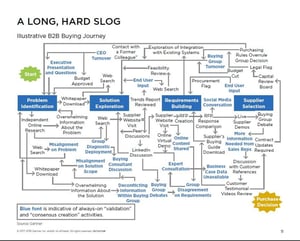Tl;dr - Every company bifurcates the marketing and sales functions. Some try to associate them under a CRO type role, but they remain distinct. This has to change. Buyers don't care - they just want answers, insights, availability to experts and convenience...when and where they want it. Here's how industrial manufacturers need to adapt.
Buyers Don't See a Line Between Sales & Marketing in B2B Industrial Sales
It's a trick question. There is no line.
 Yet, if you're like most industrial companies you probably answer from the perspective of your vestigial org structure.
Yet, if you're like most industrial companies you probably answer from the perspective of your vestigial org structure.
A small marketing department (trade shows, website, journal ads, and a bit of marketing communications) and a much larger sales organization.
It feels appropriate because that's the way it's always been.
The background question, however, is who should feel comfortable? You? Your VP of Sales? Your Marketing Director?
Nope.
Your prospect, buyer, and customer.
They're the only ones that need to feel comfortable with the resources you have arrayed to help them. And the best way to make them comfortable is to make it transparent. In other words, to make communication easy and convenient for them, in the channel they want, when they want. To make learning more simple and efficient. To quickly reach someone live when they want that interaction. And even, to help them understand how to buy what you sell - remember you sell it routinely while they only buy it periodically.
No buyer says to themself..."Self, since my next question is whether this product will solve my problem I need to decide who to speak to. That's probably something that marketing answers. So let me check with the marketing team for an answer." Nor would they say "I wonder if marketing or sales is better to help me understand how long it takes to implement? I better figure out who to talk to first, in order to get the answer."
Buyers don't care about your structure. They care about their needs. Therefore there is no line between marketing and sales teams - there's simply a continuum. And as convoluted buying journeys become ever more attenuated, buyers will frequently slide back and forth along that continuum.
It Takes a Team to Make it Easy for the Buyer
But, you're probably muttering, "there are completely different skills across those disciplines!"
Of course, you're right. You need content creators, sales engineers, data analysts, and more. Each will have specific skills.
In other words, you need an integrated team to deliver a comfortable buyer experience - and they need to be clear that they're working together with that strategic objective. The integration needs to be meticulously planned to ensure smooth handoffs. The technology stack, which will likely be controlled by marketing and IT, is an important tool in pulling all this together. For example, automatically alerting a sales rep to the fact that one of her target accounts is on the pricing page so that they are prepared to immediately join a live chat with the buyer could help to quickly move that chat to a scheduled meeting or an immediate Zoom session.
Sales enablement (we might be better off calling it buyer enablement to truly characterize the collaboration between marketing and sales to help the buyer) is critical here. A recent Harvard Business Review article1 identifies this as one of the key aspects of sales and marketing alignment. "Provide the sales team with knowledge about prospects for their sales calls" it suggests, and goes on to call out a couple of examples including the intent details of the prospects' site behavior and what might be gleaned from that. This is particularly important, the article explains, because of the COVID driven acceleration of existing B2B Buying trends. "One-third of buyers spend more time on pre-purchase research, but one-quarter of buyers spend less time talking with vendors."
There's a Term for That - Consilience (Or ORE™)
Consilience is a word that means "the linking together of principles from different disciplines especially when forming a comprehensive theory." That captures the essence of the industrial sales and marketing alignment imperative to satisfy today's buyers.
Our concept of Overall Revenue Effectiveness™ (ORE) captures the same linking together of disciplines within a framework that addresses the intricacies and complexity of the complex sales journeys, industrial marketing strategy, traditional sales, buyer expectations and buying process, and large buying teams common in capital equipment sales these days.
A recent McKinsey report2 illustrates why an integrated framework is critical. "To equip (today's buyers) to navigate this complex omnichannel ecosystem, sales professionals will increasingly need to become 'journey orchestrators,' directing customers to different types of channels for experiences that sellers in the past might have completed themselves." Key insights include:
- B2B customers now regularly use ten or more channels to interact with suppliers (e.g. face-to-face, telephone, email, website, ChatBot, Zoom, etc.)
- Customers employ a roughly even mix of traditional sales, remote, and self-service at each stage in the sales process
- 2/3 of buyers opt for remote human interactions or digital self-service
- Ecommerce has surpassed in-person selling as a channel (and 35% of buyers will use ecommerce for purchases =>$500,000 while 77% will do so for =>$50,000)
- Buyers do skew toward in-person sales for first-time, complex, and high-value sales, and in-person visits are perceived as a manifestation of the seller's commitment to the buyer.
- Table stakes (requirements for >80% of buyers) include expectations of availability of pricing online, always-on customer service, and consistent experience across channels
- 89% of respondents say marketing and sales need to work closely together - yet 57% report that sales teams still fail to leverage content created by marketing
And, btw for those of you saying "But my industry is different!" McKinsey notes that the "assertion conflicts with (the) survey data." This is particularly important for capital equipment companies that engineer and build to order.
Implications for Manufacturing Marketing and Industrial Sales
This is a dramatic change from the days when marketing ran trade shows and journal ads and passed a couple of leads to the sales team. That means there are implications to sales process, marketing strategy, org chart, resource allocation across sales teams and marketing teams, and more. Let's look at a few.
Sales Training and Skills
Modern B2B sales teams will have to learn new tools, new tactics and new language. Sales processes have to be adapted and responsibilities revisited. Who monitors a chatbot, for instance? Sales? Marketing? Depending on the page and inferred intent? And who follows up on a lead from a prospect that fits the ICP vs. one that doesn't fit the ICP?
You're going to need skills, training and perhaps new people. The place to start is by understanding what you have, using a sales force evaluation tool (that will also include your non-sales folks, like marketing) that goes beyond simple personality screening. You need a tool to evaluate both whether someone can sell and whether they WILL. As you upgrade/expand the team you're going to want to assess candidates to find the quality ones which you should interview.
Tweak the Sales Model
 Your sales model may rely primarily on face-to-face interactions in the field. Those will remain important at certain points in certain types of transactions, but following McKinsey's rule of thirds, you'll need salespeople who are skilled digital and remote sellers (they might also be your face-to-face folks) and also some inside sales for both inbound lead follow up and for outbound sales efforts.
Your sales model may rely primarily on face-to-face interactions in the field. Those will remain important at certain points in certain types of transactions, but following McKinsey's rule of thirds, you'll need salespeople who are skilled digital and remote sellers (they might also be your face-to-face folks) and also some inside sales for both inbound lead follow up and for outbound sales efforts.
When a prospect visits the site and initiates a chat, are they a lead? At least a qualified lead that you want to hand off to a salesperson who's also managing active projects and closing high dollar opportunities? Probably not. You'll need different functions such as BDR and SDR (business and sales development reps.)
Sales Compensation
Your rainmakers will object, but you'll probably have to change their comp plans. After all, you built those based on the fact that they were responsible for prospecting, territory management, extensive travel, and detailed technical knowledge.
As buyer behaviors evolve the prospecting will be self-service in many cases, and much more reliant on high levels of activity than in the past. That means the SDRs will carry the burden, particularly of low return and unpleasant work, and they're relieving field sales of some of that. Technically focused inside sales engineers can join business-focused field sales folks in hybrid sales calls. You'll have to adjust compensation to reflect where burdens reside and what value roles create. (That being said, in early 2022 expectations are increasing. If you're selling complex capital equipment anticipate at least $100K to have a capable salesperson - with sizeable commission opportunities beyond that.)
KPIs and Performance/Activity Expectations
You can't manage your sales effort by quota attainment anymore. This is a much more nuanced and complex environment, and as noted above the integration of marketing and sales is critical. So you're going to have to create sensible management dashboards and KPIs to ensure that the integration is sound and that each element is working toward common objectives rather than simply individual or departmental vanity metrics.
An Adequate Online Presence
When you visualize the complexity of this omnichannel approach you realize that most industrial marketing websites are inadequate. The brochure approach simply doesn't provide the information or the tools that buyers expect or that sales will need to engage them.
Capital equipment companies need to start to include chatbots for conversational marketing and sales, e-commerce capability, an integrated knowledge base, and a customer portal through which customers can check on order history, obtain operators manuals, confirm warranty status and agreement expiration dates and more.
Your B2B website needs to be much closer to a strong B2C website than you've probably considered.
Marketing and Sales Have Collided
The bottom line is that while there's certainly a range of unique skills necessary and numerous discrete functions across this revenue growth continuum, from the buyer's perspective (the only one that really matters) there is no longer any distinction between sales & marketing functions.
Companies that thrive will accept that, adapt their org charts and resource allocation, and invest in the infrastructure, B2B industrial sales talent, marketing skills and training to create experiences for buyers that are table stakes to compete.
References
1. Are Your Sales and Marketing Teams on the Same Page?
2. B2B Sales: Omnichannel everywhere, every time


